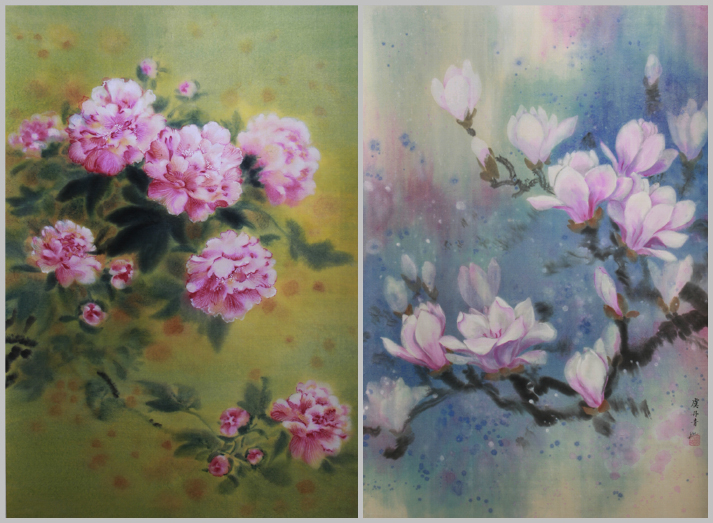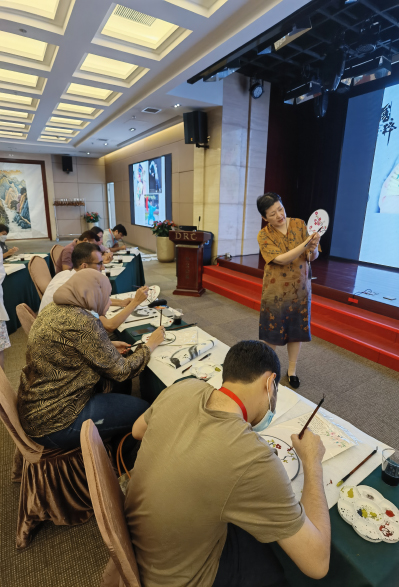A Chinese Painter Dedicated to Cross-cultural Communication through Art

Yu Danqing's traditional Chinese ink painting works
Yu Danqing hosted her first art exhibition in Beijing in late 1992, at the age of 21. It was at that event she met two expats who were so enraptured by her work, and by Chinese painting, that they asked her if she would become their teacher.
Three decades later, Yu, now an internationally renowned and multi-award-winning artist, is still helping visitors and expats understand Chinese culture,
teaching traditional wash painting, calligraphy and history. "Art has no borders. It is one of the best channels to build understanding, reduce estrangement and prejudice, and create a peaceful world," Yu told Beijing Review.
"It's wonderful to feel the Chinese art," Hendy Yuniarto, an Indonesian working as a lecturer at Beijing Foreign Studies University, said after completing his first painting during Yu's painting course. "It is also a very historical experience to have this hands-on training in an art that can be traced back more than 2,000 years."

Yu Danqing teaches international journalists to apply Chinese painting techniques to fans in Beijing in 2022
A bridge of cultures
Yu was born in 1971 into a family in Beijing with an illustrious artistic background. Yu Shinan, known as one of the four great calligraphers of the early Tang Dynasty (618-907) is her ancestor. Her grandfather Yu Zhongheng was an aficionado of traditional Chinese culture and her mother was a Peking Opera performer who established a performing troupe together with other family members. Influenced by them, Yu Danqing was exposed to the arts at an early age and began learning Chinese painting at the age of 7.
In addition to painting, she'd also learned other aspects of traditional Chinese culture from her family, including history and customs. She also studied English and French under the instruction of her uncle Yu Qilong, who was a calligrapher and worked in diplomatic service. This exposure to traditional culture and her early adoption of these languages made her a natural ambassador for Chinese culture and arts.
In 1992, Yu Danqing and her uncle were invited to give a cultural lecture at the Embassy of the Kingdom of the Netherlands in Beijing, where her first painting exhibition took place. She said in the lead-up to their lecture, she'd rehearsed her explanations of aspects of Chinese culture in ways that would be interesting and easy to understand for people from overseas. She remembers her audience being fascinated by Chinese culture.
When the attendees asked her how to remember Chinese characters, which were too abstract for them to write, she used an example of the ideograph for "horse."
"Ideographs are a kind of pictograph that looks similar to the concept they describe," Yu Danqing said. "The original character for horse looks like a real standing horse with its head turning back. Over time, the character has been simplified into the current form." She showed the audience what the character looked like in different dynasties. After learning about the evolution of Chinese characters, the audience said it was the first time they had been given an understanding of Chinese writing and they didn't realize how fun it was. They told Yu Danqing they would introduce what they'd learned to their family members and friends at home, or even bring them to China to learn more if possible.
"At that time, I felt I was doing something very meaningful," Yu Danqing said, adding that teaching expats Chinese culture started to grow on her and made her happy. So far, she has taught around 1,000 people from all over the world.
Today, Yu Danqing is regularly invited to give lectures at the Beijing Language and Cultural Center for Diplomatic Missions, a public institution founded in 1956 that specializes in teaching Chinese as a second language and offering cultural courses.
Yu Danqing said now many foreign envoys invited by government organizations like the Foreign Ministry and the Ministry of Commerce, as well as employees from overseas companies, come to the center to participate in cross-cultural communication activities. "In fact, the channels of communication are diverse. It's not restricted to the government level; anyone can be a messenger of culture. We're all responsible for spreading our fine culture and learning from the best of other civilizations," she added.
Exchange and change
Chinese ink painting has traditionally made great use of negative space, offering the viewer more room for imagination and contemplation. In comparison, many Western artists apply color over the entire surface of the piece to make the work look more realistic.
Talented at painting still life, especially flowers, she has integrated Western painting elements into some of her Chinese paintings, filling the background with colors and introducing focal points and sources and focuses of light, thus creating a different visual experience from traditional ink paintings in black and gray tones. "This seems to be more popular with younger audiences," Yu Danqing said.
Despite the innovations she has made, the fundamental essence of ink painting—the skill shown in the brushstrokes—cannot be changed. "The strength and softness of the brush strokes show unique inexpressible charms. Even one seemingly simple stroke may take years of practice to approach perfection," she explained.
Over the years, she has given lectures and hosted exhibitions around the world and has witnessed the transformation of how people view China and its culture.
"I remember when I was at a vineyard in Cognac, France, in 1994. The owner stared at my feet for a bit and checked if my feet were bound like those of women in ancient times," she said. "However, more than 10 years later, when I was walking on a street in Paris, a young man tapped on my shoulder and said 'Nihao' [Hello in Chinese], and asked if he was saying it right. This is an interesting change, and I am confident that now people are more up-to-date about China."
Yu Danqing believes that, in addition to paintings and calligraphy, there are more platforms for people to gain an understanding of China, such as movies, television series, publishing and even modern technologies. "Sure, there are challenges in transnational communication, but as long as we respect each other's culture and have an open mind, such barriers won't be much of a problem," she concluded.